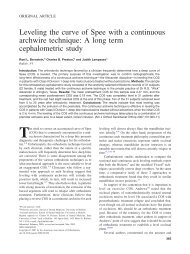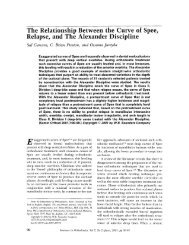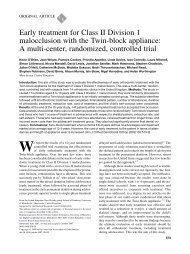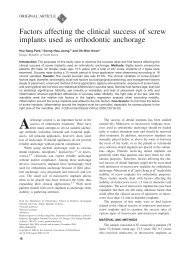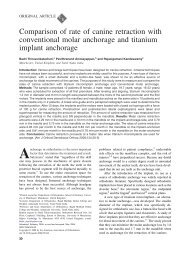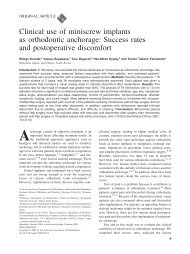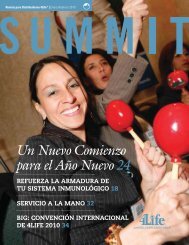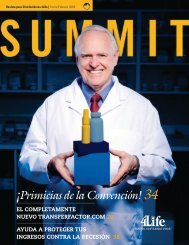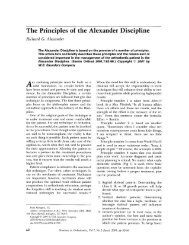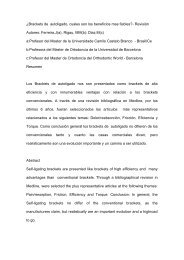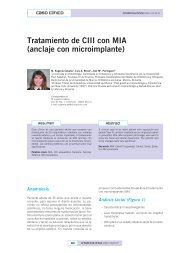Biomechanical and histological comparison of self-drilling and self ...
Biomechanical and histological comparison of self-drilling and self ...
Biomechanical and histological comparison of self-drilling and self ...
You also want an ePaper? Increase the reach of your titles
YUMPU automatically turns print PDFs into web optimized ePapers that Google loves.
46 Chen, Shin, <strong>and</strong> Kyung<br />
microimplants in the 2 groups. After 9 weeks <strong>of</strong> observation,<br />
PRT—the force <strong>of</strong> the maximum counterclockwise<br />
movement to loosen the microimplants—was<br />
measured with the same machine for 12 stable microimplants<br />
at symmetrical sites in each group.<br />
The stability <strong>of</strong> the microimplants was measured<br />
with dental tweezers; failure was defined if a microimplant<br />
could be moved in any direction after the 9-week<br />
observation period.<br />
A vital staining procedure was used for the animals.<br />
Oxytetracycline (15 mg per kilogram per day) was<br />
given intramuscularly for the first 4 days after the<br />
microimplants were placed. A subcutaneous injection<br />
<strong>of</strong> 1% calcein (15 mg per kilogram per day) was given<br />
at the fourth week, <strong>and</strong> 0.16% alizarin red (75 mg per<br />
kilogram per day) was injected intramuscularly at the<br />
seventh week.<br />
The anesthetized dogs were killed by intracardial<br />
perfusion with neutral 10% formaldehyde solution. The<br />
maxillary <strong>and</strong> m<strong>and</strong>ibular bones containing microimplants<br />
were dissected. The specimens were fixed in the<br />
same solution for more than 24 hours. After being washed<br />
with distilled water, each implant area was separated with<br />
a saw (D-54518, Proxxon; Woo Sung E&ICo,Ltd,<br />
Tokyo, Japan).<br />
Fourteen microimplants with surrounding tissue were<br />
selected for histologic evaluation from the 2 groups at<br />
symmetrically interradicular areas <strong>of</strong> the maxillae <strong>and</strong> the<br />
m<strong>and</strong>ibles <strong>of</strong> the 2 dogs. These specimens were infiltrated<br />
with vilanueva bone stain propylene oxide from a starting<br />
solution <strong>of</strong> 70% alcohol <strong>and</strong> stained. This procedure<br />
included 11 steps <strong>and</strong> lasted more than 3 weeks.<br />
Before being embedded in vilanueva bone stain<br />
propylene oxide, the specimens were dehydrated <strong>and</strong><br />
defatted with graded ethanol. Each embedded implant<br />
with bone was sectioned sagittally with a low-speed<br />
digital saw (Accutom-50; Struers, Ballerup, Denmark)<br />
into thicknesses <strong>of</strong> 500 m. These sections were<br />
ground with a grinding machine (Rotopol-35; Struers)<br />
until the implants <strong>and</strong> the surrounding tissues could be<br />
seen clearly. Microscope slides, prepared by mounting<br />
American Journal <strong>of</strong> Orthodontics <strong>and</strong> Dent<strong>of</strong>acial Orthopedics<br />
January 2008<br />
Fig 2. Placement <strong>of</strong> microimplants in dog jaw with force applied by nickel-titanium coil springs: A,<br />
SDI; B, STI.<br />
Table I. Comparison <strong>of</strong> peak insertion torque values<br />
between groups (in Ncm)<br />
Group (n 14 each group) STI SDI P<br />
Maxilla 3.5 2.1 5.6 1.1 .017<br />
M<strong>and</strong>ible 7.4 1.1 8.7 2.3 .029<br />
Significance, P .05.<br />
the flattened sections with low fluorescence, were<br />
observed with a light microscope <strong>and</strong> a fluorescent<br />
microscope.<br />
Histomorphometric analysis was performed on the<br />
digitized images from the microscope with a camera<br />
system (Olympus, Tokyo, Japan). The images obtained<br />
with 100-times magnification were combined into 1<br />
figure including the entire implant surface <strong>and</strong> analyzed<br />
with image analysis s<strong>of</strong>tware (Image & Microscope<br />
Technique, Goleta, Calif). For each microimplant, the<br />
bone contact sections were measured <strong>and</strong> expressed as<br />
percentages <strong>of</strong> BIC.<br />
Data are expressed as means <strong>and</strong> st<strong>and</strong>ard deviations.<br />
The differences between the SDI <strong>and</strong> STI groups<br />
were evaluated with the Student t test. A P value less<br />
than .05 was considered significant.<br />
RESULTS<br />
Not all the microimplants remained firm enough<br />
during the experimental period. In the STI group, the<br />
overall success rate was 86%; 4 microimplants loosened<br />
<strong>and</strong> tipped. Two failures occurred in the SDI<br />
group; 1 microimplant loosened, <strong>and</strong> another in the<br />
distal region <strong>of</strong> the m<strong>and</strong>ibular second molar fractured<br />
in the fourth week. The success rate was 93%.<br />
Mild inflammation <strong>and</strong> swelling <strong>of</strong> the alveolar<br />
gingivae were observed on both sides <strong>of</strong> the maxilla<br />
<strong>and</strong> the m<strong>and</strong>ible. They were more serious on the left<br />
side in both dogs.<br />
The <strong>comparison</strong> <strong>of</strong> the PIT values taken at the<br />
beginning <strong>of</strong> the experiment showed significant differ-



